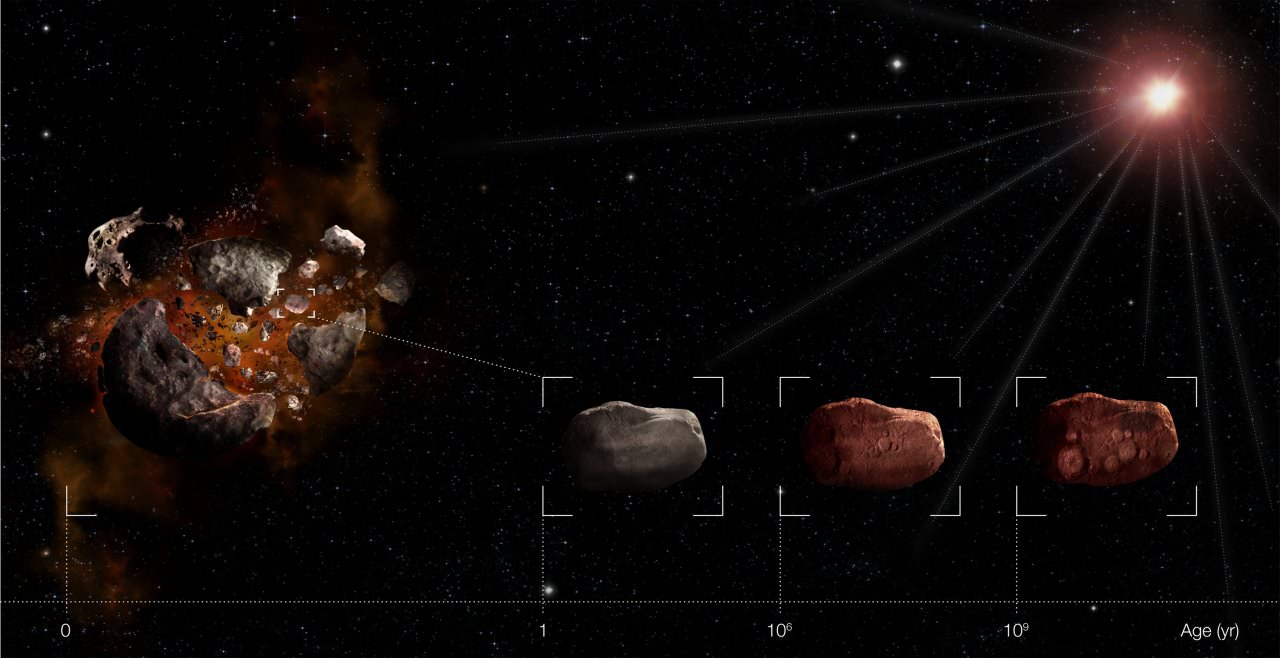[/caption]
If you stay out in the Sun too long, you’ll eventually get a suntan (or sunburn); your skin will also get damaged and it will show signs of ageing faster. This might sound like a sunblock ad, but the same principal holds true for the small chunks of rock floating around in the Solar System. Yes, a young asteroid’s surface will age prematurely, but it’s not caused by the Sun’s ultraviolet rays, it’s caused by the solar wind…
Within a million years, an asteroid can turn from lunar grey to Martian red when left out in the solar wind. A million years is a tiny amount of time in relation to the Solar System’s lifetime. Why is this important? European Southern Observatory (ESO) researchers have realized that this finding will not only help astronomers relate an asteroid’s appearance with its history, but it can act as an indicator for after effects of impacts with other asteroids.
It turns out that the study of “space weathering” is fairly controversial, scientists have been mulling it over for a long time. Central to the problem is the fact that the appearance of the interior of meteorites found on Earth are remarkably different to the asteroids we see in space; asteroids are redder than their meteorite cousins. So what causes this redness?
“Asteroids seem to get a ‘sun tan’ very quickly,” says lead author Pierre Vernazza. “But not, as for people, from an overdose of the Sun’s ultraviolet radiation, but from the effects of its powerful wind.”
Although this is an interesting discovery, the speed at which the “tanning” occurs is astonishing. After an asteroid collision, fresh asteroid chunks are created with new surfaces. Within a million years these young asteroid surfaces will turn a dirty shade of red as the surface minerals are continuously battered by ionizing solar wind particles. “The charged, fast moving particles in the solar wind damage the asteroid’s surface at an amazing rate,” Vernazza added.
Naturally, a lot depends on the mineral composition of an asteroid’s surface, influencing how red its surface will become, but most of the tanning effect occurs in the first million years. Afterwards, the tanning continues, just at a slower rate.
Asteroid observations also reveal that the high proportion of “fresh surfaces” seen on near-Earth asteroid probably isn’t down to asteroid collisions. The frequency of collisions is far lower than the sun-tanning timescales, meaning that there shouldn’t be any “fresh surfaces” to be seen. It is far more likely that the upper layers of asteroids are renewed through planetary encounters, where the gravitational field of planets “shake off” the tanned dust.
Source: ESO


A million years under the Sun woulsd turn anyone orange. =P
Nice Picture. Is that supposed to be a disintegrating planet??
i’m looking forword to the Dawn mission to Ceres ! that should reveil much more about asteroids and the origin of the solar system
I’m not too surprised about this finding. Space weathering has been seen on the rocky/dusty surfaces of the Moon, Mercury, and Mars’ 2 moons, Phobos and Deimos, to name a few. Fresh impact craters on these bodies are bright compared to ejecta surrounding older craters which has clearly darkened and is not due to exposure to UV radiation (exposure to UV radiation is thought to darken the surfaces of bodies containing volatile organic compounds like comets and some moons).
Still, one can’t avoid wondering why is it, then, that the weathered Moon’s surface is quite dark, yes, but not red by any visible measure.
@ Jorge: You stated above “Still, one can’t avoid wondering why is it, then, that the weathered Moon’s surface is quite dark, yes, but not red by any visible measure.” Um, well, differing composition comes to mind.
Perhaps, but the article is rather moot about composition. One can be lead to believe that this happens regardless of composition, with all kinds of asteroids… or all kinds of exposed surfaces, really, with the possible exception of ices.
Jorge — “moot” means “arguable,” “admissable fior debate,” ” point to argue.” I think the word you want instead of “moot” is “mute,” which means “silent.”
Interesting article. How does one determine the youthfulness of an asteroid?
Hm, yeah, OK, you’re right, but although that solves a linguistic doubt it doesn’t answer my scientific ones.